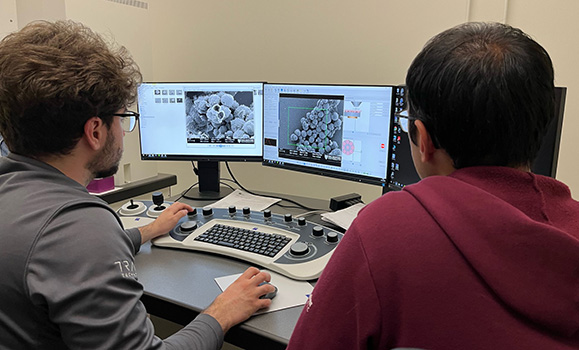News
» Go to news mainDalhousie discovery unravels a mystery of viruses under the sea

From 2009 to 2013, researchers on the French schoonerTara circled the globe collecting water samples with an audacious goal in mind: to carry out a planet-wide survey of the diversity of marine plankton that would involve 2,010 locations, 35,000 water samples and extensive genetic analysis back in the lab.
The resulting DNA sequence datasets are colossal and while they have been around for years, they continue to yield new insights into oceanic mysteries.
 Recently, a new type of virus — dubbed ‘mirusvirus' — was discovered by analyzing the data collected by Tara researchers. It was determined to be ubiquitous in sunlit oceans and to share genetic similarity with both herpesviruses and so-called giant viruses.
Recently, a new type of virus — dubbed ‘mirusvirus' — was discovered by analyzing the data collected by Tara researchers. It was determined to be ubiquitous in sunlit oceans and to share genetic similarity with both herpesviruses and so-called giant viruses.
The researchers, however, could not determine the specific organisms that mirusviruses infect in nature from environmental DNA sequences alone.
That's where Dr. John Archibald (shown right), director of Dalhousie's Institute for Comparative Genomics, and colleagues came in.
An important first step
 He and his post-doctoral student, Dr. Lucie Gallot-Lavallée (seen left), were helping to sequence the genome of an important marine microbe named Aurantiochytrium. Unusual virus-like sequences were identified in the organism’s genomic data, but they could not make sense of them — until the new mirusvirus data became available for comparison.
He and his post-doctoral student, Dr. Lucie Gallot-Lavallée (seen left), were helping to sequence the genome of an important marine microbe named Aurantiochytrium. Unusual virus-like sequences were identified in the organism’s genomic data, but they could not make sense of them — until the new mirusvirus data became available for comparison.
They soon realized that the organism they were studying in the lab has two distinct mirusvirus genomes within it, one of which is integrated directly into one of its chromosomes. This is reminiscent of the biology of herpesviruses and their ability to maintain latent infections in humans and other animals hosts.
"We are the first to identify a natural host for mirusvirus, which paves the way to figuring out how the host and virus interact with one another, and the roles mirusviruses play in marine ecosystems," says Dr. Archibald, who worked on the project with researchers at Stony Brook University in New York and the Joint Genome Institute in California.
“We don’t yet know the diversity of microbes that mirusviruses are capable of infecting in nature. But the discovery that Aurantiochytrium is a host is an important first step to sorting out the biology of host-virus interactions in the lab.
"In the long run, this will provide a foundation for understanding how mirusviruses impact microbial ecology in the sea."

Trainees working at the electron microscope. (John Archibald image)
Making the invisible visible
Viruses are the most prevalent biological entities in the world’s oceans and play essential roles in its ecological and biogeochemical balance. Yet, they are among the least understood components of the marine biosphere.
Determining the complete genetic makeup of Aurantiochytrium sets the stage for future investigations of marine protist genomes — work that may shed light on the invisible world of marine viruses and the health of oceans worldwide.
"The discovery of one of the viral sequences at one of the chromosome ends offers intriguing insights into the evolutionary ancestry of these elements,” says lead researcher Joshua Rest of Stony Brook.
"This revelation also aligns with growing evidence pointing toward mirusviruses' significant influence in marine ecosystems."
The findings are outlined in a paper published in Current Biology.
Recent News
- Dalhousie’s first physician assistant cohort steps into Nova Scotia’s healthcare system
- Dalhousie med students explore pediatric care in Austria
- Dalhousie researchers shine at Discovery Awards with four top honours
- New $2M national study to uncover how biology, social factors shape MS outcomes
- Pathology EDIA Committee makes strides during 2024‑2025 year
- CCfV’s impact on vaccine innovation
- Unlocking the secrets of memory—with fruit flies
- Celebrating mobility research and the power of philanthropy
